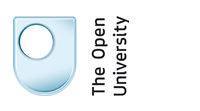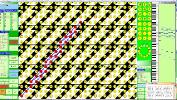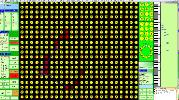

| :: | Harmony Space |
| : | Projects |
What is Harmony Space?
Coming Soon
Publications
Analysing Songs
Song Walker
Whole Body
Neurophony
Embodied Cognition
Photo Gallery
Events
Broadcast media
Presentations
History
Related Work
Guide to practical use
Site Map
Contact
Simon Holland
The Music Computing Lab
Neurophony
Neurophony is a first, exploratory design on a brain computer music interface using musical harmony. Neurophony uses EEG (electroencephalography) sensors and analysis software to control a system called Harmony Space to generate harmonic sequences reflecting the user's mood.Neurophony maps positions in the two dimensional Valence / Arousal space into harmonic processes. For this initial design, these processes took the form of simple chord sequences. To determine the nature of the chords, we were guided by insights into harmonic processes derived from the musical tool Harmony Space.
Mapping from EEG to Music – design goals
There are at least two simple, diametrically opposed, principles for guiding mappings from EEG signals to musical output: homeostasis and mirroring. For a system that implements the principle of homestasis, the aim is to maintain neutral levels of valence and arousal (or indeed to try to maintain any desired set point). So for example such a system might try to counter a high level of arousal by generating calming, slowing music, or might try to counter a negative valence (corresponding to negative emotion) by playing euphonious, pleasant music. By contrast, for a system designed to implement the principle of mirroring, the aim is simply to reflect the levels of valence and arousal detected. In this case, for example, a high level of arousal might lead to busy, excited music, and an extreme level of negative valence might lead to 'ugly' music.Neurophony is designed explore the mirroring principle rather than the principle of homestasis. There are an unlimited number of ways in which EEG signals might be mapped into music to reflect this scheme. Various broad design goals were considered to guide our choice of mapping, as follows:
1/ to use a simple mapping in the first instance;
2/ to use a linked graphical and musical output in tandem;
2/ to preserve a principled connection between the mappings used for musical
and graphical output;
3/ to minimise, within reasonable bounds, the extent to which the musical mapping
relies on learned associations from a particular genre;
5/ to choose a mapping capable of principled elaboration as further dimensions
of EEG signal become available.
This work was carried out by Fabien Leon with guidance from Eduardo Miranda and Simon Holland, in collaboration with, and with kind support of, the Interdisciplinary Centre for Computer Music Research at the University of Plymouth.



(Click on any image to enlarge.)
Project Report report_Fabien_leon.pdf
Contact